North Toronto Collegiate Institute Redevelopment/Republic
BY: CS&P ARCHITECTS
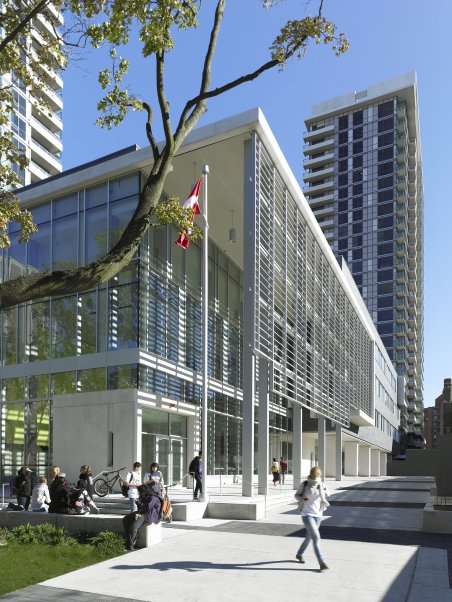
Project Name: North Toronto Collegiate Institute Redevelopment/Republic
Project Owners: Toronto District School Board/Tridel
Project Location: 17 Broadway Avenue, Toronto ON
Architects: CS&P Architects
Project Completion Date: September 2012
Project Site: Urban
Project Type: Post Secondary Education, Multi Unit Residential
Project Type Context/Setting: Previously Developed Land
Other Building Description: Educational, Residential, Public Private Partnership
Lot Size: 21,500 m2
Building Gross Floor Area: NTCI: 14,565 m2 | Republic: 46,451 m2
Building Footprint: NTCI: 5027 m2 | Republic: 1963 m2
The vision for the North Toronto Collegiate Institute Redevelopment project was to create a sustainable, state of the art replacement school (NTCI) and integrated Residential Development (Republic). The project, made possible through a unique and innovative partnership between the Toronto District School Board and Tridel, obtained school construction funding leveraged from the residential development. Innovative green loan financing based on utility payback and life cycle costing was used to enable premiums associated with LEED and energy reduction targets
The NTCI Redevelopment is a role model for similar integrated public/private developments, in the leveraging of institutional funding through development. The extensive community participation in the design of both the school and residential buildings has set a precedent for similar integrated developments in the City.
The project includes a 4-storey, 156,000 sf school, two condominium towers with approximately 500,000 sf of residential development, a full-sized, artificial turf athletic field, and a tree-lined walkway with public art, which functions as a new public through block pedestrian access route. The four story secondary school building is designed to accommodate 1206 students and includes standard classrooms, science, art, music and drama classrooms, a 600 seat theatre, library, and triple gymnasium. Each of the three major buildings on the site have a unique and distinct identity, but together form a unified and coherent development, and compelling sense of place.
The goal and success for this project has been to create an exemplary, sustainable school and integrated residential development as a model healthy environment for the community. Through an integrated design process, the school and residential buildings have obtained LEED Gold certification.
Sustainable Metrics
-
Annual energy consumption: 2,875,000 ekWh
-
Energy density: 200 ekWh/m2
-
Energy consumption savings over MNECB baseline: 54%
-
Building full time equivalent population: 1267 people (School)
-
Annual potable water consumption: 5,760,919 L/y
-
Annual potable water: 4,546 L/person
-
Water consumption savings over baseline: 37.4%
-
Percentage recycled material content by cost: 26.87%
-
Construction waste diversion: 63%
-
Percentage regional materials by cost: 49.45%
TOP
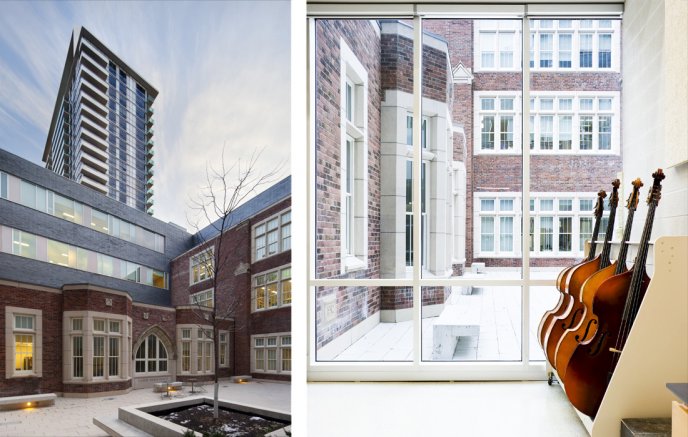
Left: New NTCI CourtyardRight: View from Music Rooms into Courtyard
An earlier feasibility study had determined that extensive renovation to the existing historic Gothic Collegiate School, originally built in 1912, was not a viable option. In the redevelopment project, key historical components were preserved from the original school, and reinstalled in the school’s central courtyard. The original brick archway entrances are reconstructed from original components, including the original school wood doors, to become the new entrance to the Courtyard. Selected archway and stone elements are reclaimed and reinstalled, and the brick is salvaged and reclaimed. This heritage strategy was key to gaining community acceptance for the demolition of the existing school, and central to the school design concept. The new school metaphorically ‘wraps’ the embedded original one, reinforcing it’s symbolic presence as the heart of the new building.
 Section through heritage courtyard
Section through heritage courtyard
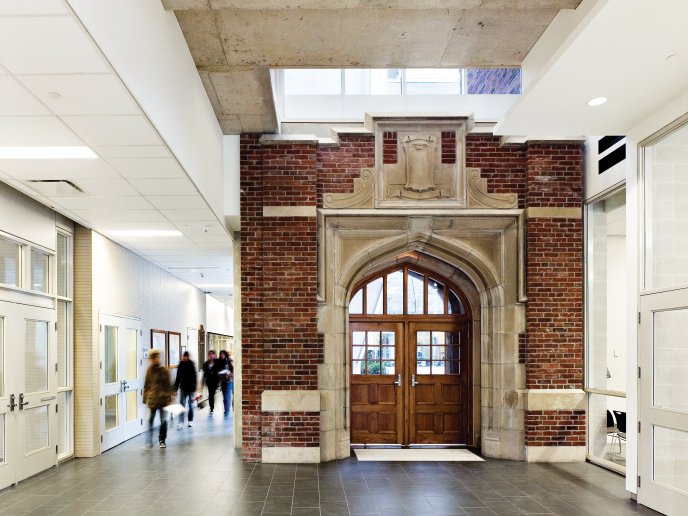 Historic reclaimed archway as entrance to the new Courtyard
Historic reclaimed archway as entrance to the new Courtyard
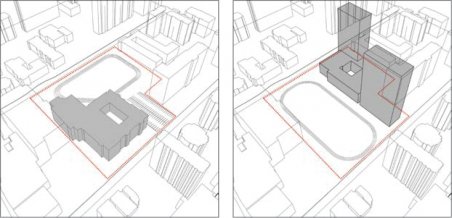 Left: Original School. Right: Redevelopment
Left: Original School. Right: Redevelopment
TOP
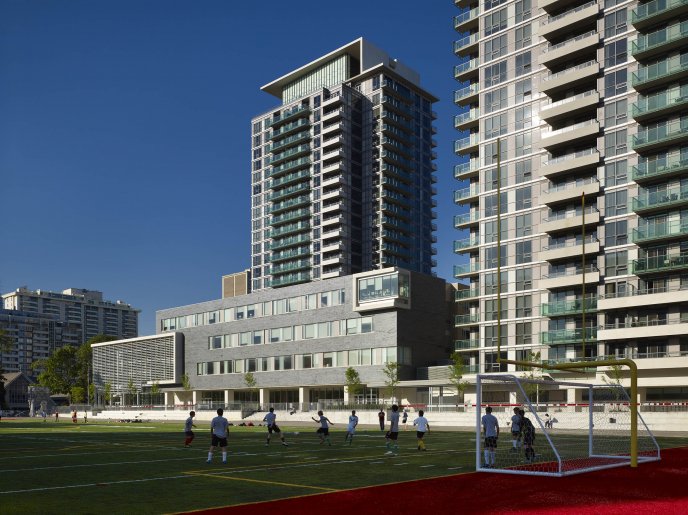
New Redevelopment and Open Space
The NTCI Redevelopment project was designed to create an exemplary mixed use development that would make a significant contribution to the life of the community. The site for this project, located in midtown Toronto, is in close proximity to local amenities including high level public transit, a vibrant main street, and an established residential neighbourhood. The 450 unit residential development contributes to the intensification of the site and to the City’s targets for reurbanization, adding vitality and activity, and helping to reduce sprawl and automobile dependence.
On the ground level the dramatic three story theatre lobby, performance hall, and continuous glazed hallway to the school ‘porch’ overlooking the field, provide an iconic civic presence to the building. The theatre and other school amenities, including the track and field, will be permitted for community use. A carefully crafted amenable public walkway offering places to sit, provides a new through block route which knits the community together in new ways.
The project is located in a downtown apartment neighbourhood which is steps to a subway, reducing car dependency. A minimum level of underground parking spaces was provided. Preferred parking for alternative hybrid vehicles is provided in the underground garage, with electrical plugs included in the parking facility. Zipcars has space within the facility for short term rentals.
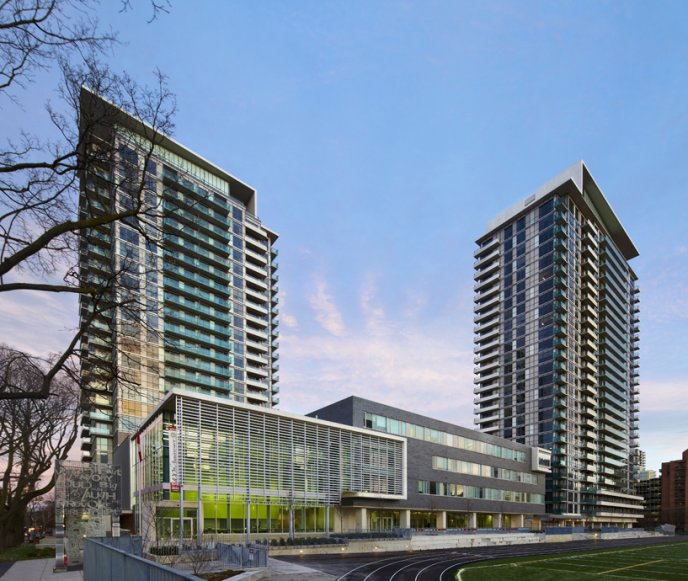
View Looking East from Broadway Avenue
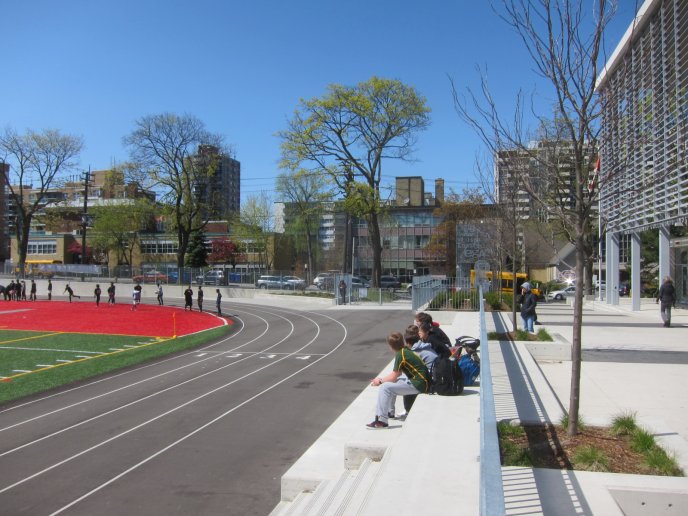
Bleacher seating along the new Track and Field
TOP
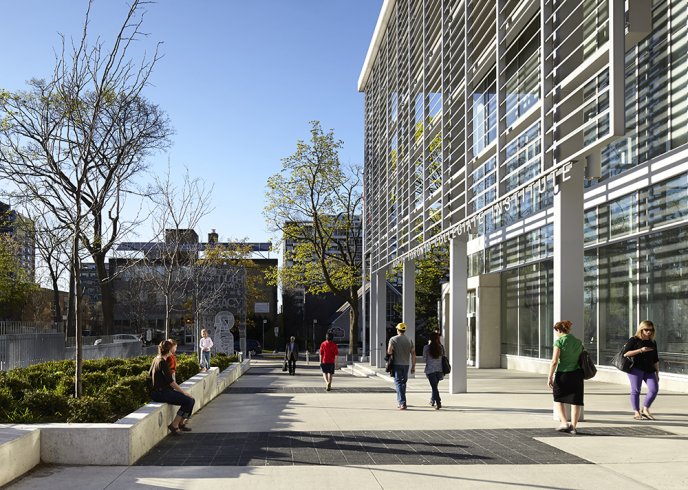
New Through Block Walkway
Land use efficiency is achieved by minimizing the building footprint and maximizing community open space. Urban design objectives reinforce the edge conditions of the public realm, with a high level of landscaping, public art, and public amenity. A strong, well articulated, low rise school is the major anchor to the site. The individual identities of each building on site are articulated to create an integrated, coherent composition.
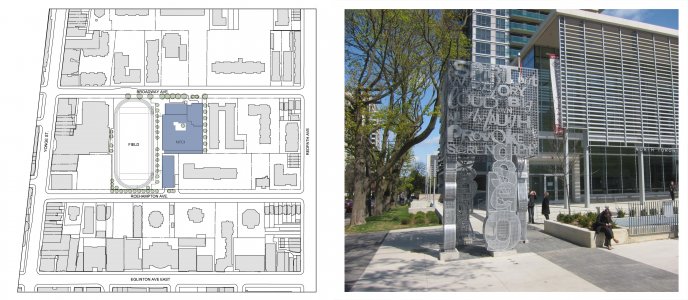
Left: Site Plan. Right: Public Art at Broadway Avenue
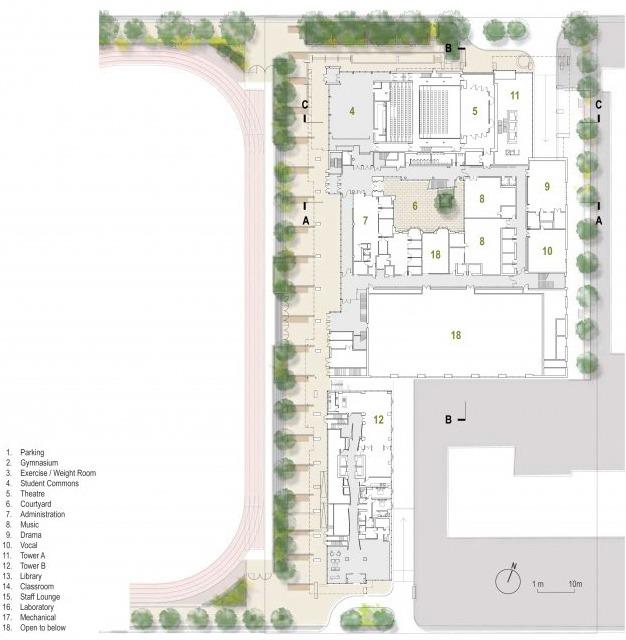
Site Plan/ Ground Floor
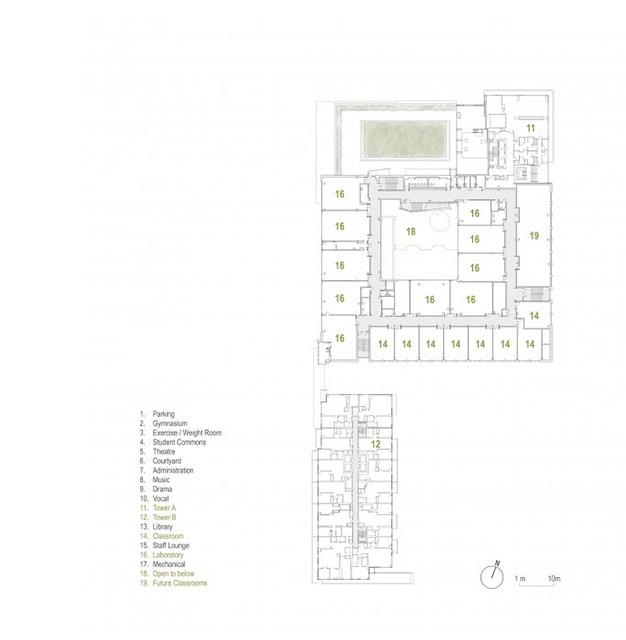
Fourth Floor Plan
TOP
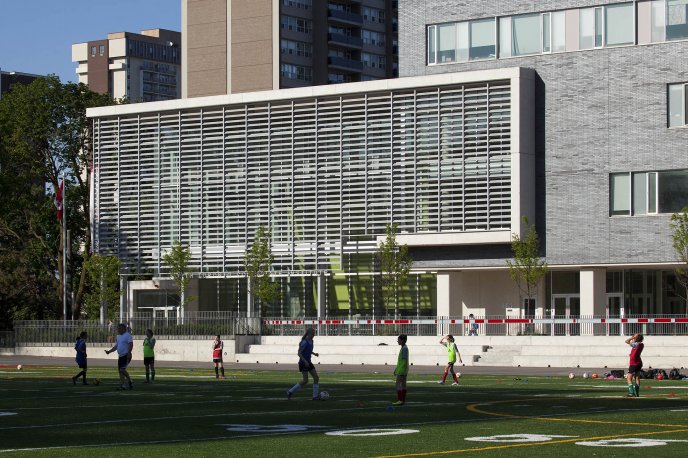
View Looking East at Sun Shade
An extensive green roof over the school and full size track and field increase green space, promoting storm water management and habitat. Green roof planting reduces summer heat gain and provides useful retention and filtration of roof runoff draining to the stormceptor storage facility under the field. Existing mature maples trees along Broadway Avenue are protected. Native species are used in plantings to increase hardiness and drought tolerance.
Day lighting design features also contribute to energy efficiency objectives by utilizing the thermal mass of the building to harvest passive solar energy. An aluminum sun shade is provided on the west facade to moderate heat gain in summer. Operable windows in the glass facade provide natural ventilation opportunities.
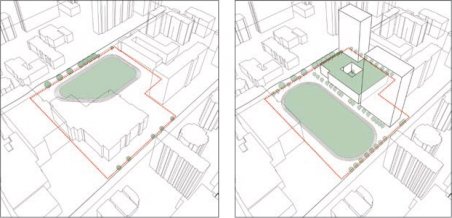
Left: Original Green Space. Right: Redevelopment Expanded Green Space
TOP
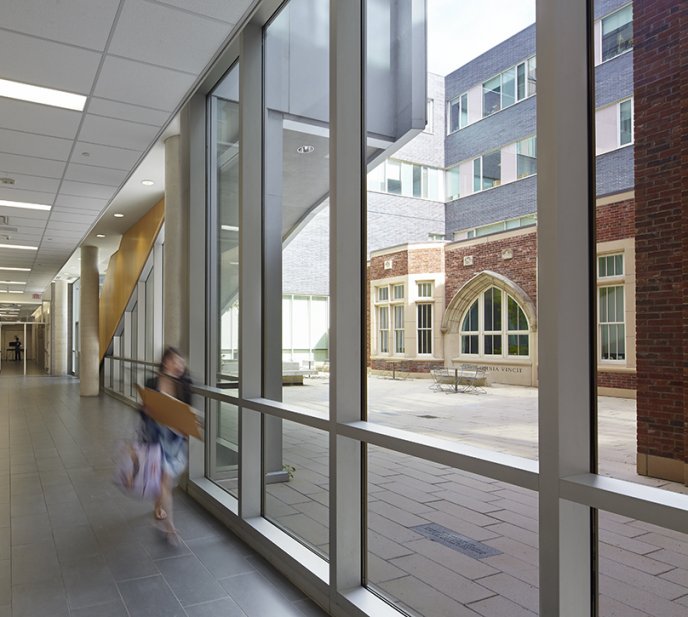
Central Courtyard and Daylighting
Day lighting has been adopted as a primary design feature for the project, significantly impacting orientation and building layout. The design for the school is conceived around a major courtyard space, which provides daylight, views, orientation and accessible outdoor social and program space. Operable windows are provided into every habitable space and corridor to provide natural ventilation. Window and glazing design increases passive solar heat gain in winter and minimizes cooling load in summer by shading windows. The school incorporates a translucent insulated glazing product into portions of the classroom windows, which maximizes the radiance within the classroom and reducing artificial lighting required, as well as reducing cooling and heating load by providing thermal insulation.
A displacement ventilation system provides low velocity fresh air to the classrooms, reducing fan energy and increasing air quality.
Occupancy sensors and switching options within classrooms reduce lighting energy load. High performance glazing provides natural day lighting and energy efficiency. Low emissivity coatings limit solar gain on glass.
High indoor air quality and comfort were key objectives. A monitored BAS System controls the operation of the ventilation system. The building utilizes local control of HVAC systems, CO2 monitoring, and materials with low VOC emissions.
TOP

Extensive Green Roof Over School
A green roof over the school provides improved storm water management and thermal performance, with no irrigation required. A stormceptor cistern is provided under the field, to release stormwater slowly into the sewer system, reducing runoff quantity. Water efficiencies target a 30% reduction, with sub metering of water and utilities in the residential units.
Technologies used for water conservation include low flow dual flush toilets, ultra low flow urinals, low flow kitchen faucets, and metered taps in the school. Native, hardy drought resistant species are used in the planting on the site planting. Very high efficiency drip irrigation is provided to walkway planting, with no other irrigation on site. Sub metering of water and utilities, is provided in the condos. A total of 19.5 ML is saved annually.
Sustainable Metrics
-
Annual potable water consumption: 5,760,919 L/y
-
Annual potable water: 4,546 L/person
-
Water consumption savings over baseline: 37.4%
TOP
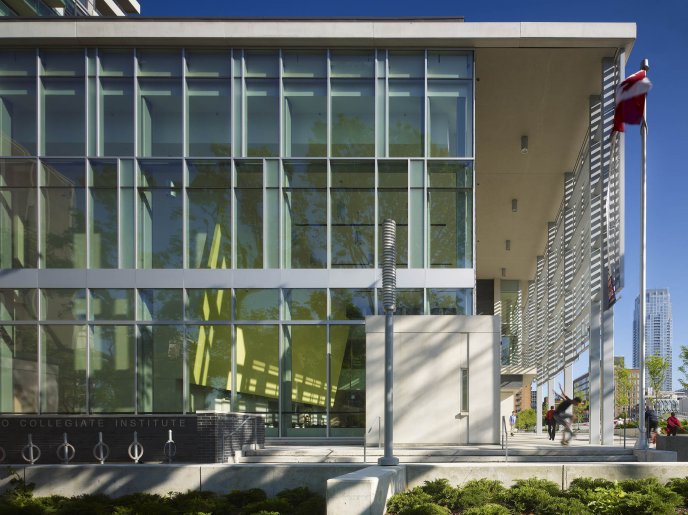
Student Commons Elevation
Both the residential buildings and school use advanced strategies to increase energy efficiency by 40% over the MNECB, reducing GHG by 1400 tonnes. Energy efficiency strategies include a high performance, durable building envelope, concrete thermal mass, and heat recovery. Best practice, third party commissioning ensures efficient operation of the systems, together with continuous meter monitoring and verification. For a healthy indoor environment the project includes a compartmentalized ventilation system, programmable thermostats, and low-emitting adhesives, paints, and carpets.
A key energy efficiency measure for the project was the provision of a well insulated high performance building envelope. Upgraded insulation to walls and roofs was provided. High performance windows was provided, argon filled and with warm edge spaces, as well as insulated translucent glazing to 25% of classroom and school windows. This significantly reduces energy costs for the building, and as well improves occupant comfort. The LEED Durablility credit was achieved, due to third party building science review of envelope detailing, from early design stages to site installation review. This ensured that the envelope quality was built as envisaged.
The school concrete slabs are embedded with radiant heating and cooling coils. This allows for thermal mass to passively store thermal energy and release slowly over time, reducing energy loads. The concrete floors act as heat sinks where heat is retained for use in the winter, and shed during the night time cooling cycle in the summer. Heating is decoupled from ventilation and is provided by an in-floor radiant system within classrooms. For a healthy indoor environment the project includes a compartmentalized ventilation system, programmable thermostats, and low-emitting adhesives, paints, and carpets.
Displacement ventilation provides low level velocity cool fresh air to the classrooms. This cool air heat and rises though natural convection to exit through high level returns. Air within the classroom becomes stratified with the high ceiling space, and not turbulently mixed. This significantly reduces fan energy required, and increases the quality of fresh air within the occupied zone of the classroom.
Other measures include heat recovery, best practice commissioning, thermal comfort humidification, and CO2 monitoring to promote long term sustainability and improved indoor environment. Energy efficient lighting is provided; occupancy sensors; variable frequency drives, and energy efficient mechanical equipment. Most of the roof is planted with native sedum, reducing the urban heat island effect. The roof plantings also reduce interior building temperatures in the summer.
The residential buildings use individual unit ERV’s, sub-metering of utilities, low flow fixtures, and building envelope improvements to deliver high energy and water savings. For a healthy indoor environment the project includes thermal comfort and low-emitting adhesives, paints, carpet, and composite wood. The residential buildings had controlled fenestration design, with the vision glazing to a maximum of 40% of the exterior wall.
Sustainable School Metrics
-
Annual energy consumption: 2,875,000 ekWh
-
Energy density: 200 ekWh/m2
-
Energy consumption savings over MNECB baseline: 54%
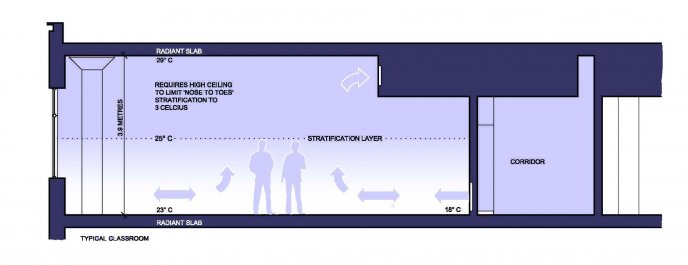
Displacement Ventilation Diagram
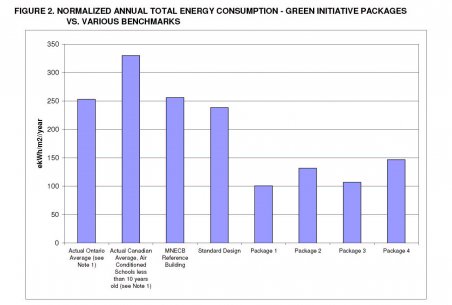
TOP
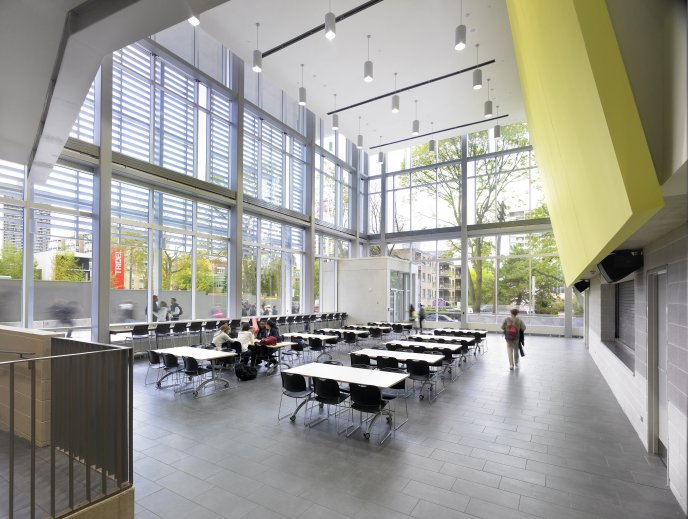
Student Commons Interior View
For a healthy indoor environment the project includes CO2 monitoring, thermal comfort humidification, and low-emitting adhesives, paints, carpet, and composite wood. All wood on the project, including the gym floor and millwork is FSC certified. Durable low maintenance building finishes and systems are utilized throughout, to ensure long term performance and low emissions. Economy of resources is deployed in construction, with a reduced level of finishes. The majority of classroom ceilings are exposed concrete with no finishes.
A very high level of recycled material was employed in the school, as well as a very high level of regionally sourced material. Construction waste recycling was also taken to exemplary levels.
Significant heritage components of the original School building have been salvaged and reinstalled, and are integrated into the design of the courtyard and main entrance corridor. This includes reclaimed brick walls, original entry portals, stone window trim, archways and other elements.
Sustainable Metrics
-
Percentage recycled material content by cost: 26.87%
-
Percentage regional materials (within 800 km) by cost: 49.45%
-
Construction waste diversion: 63%
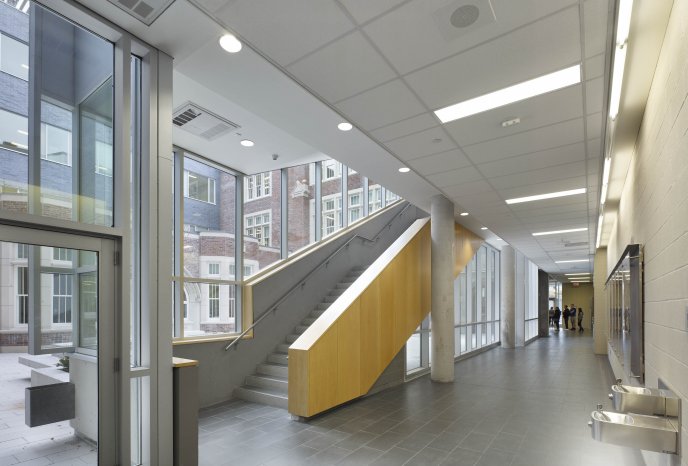
FSC Wood, Recycled, Regional, Low VOC Materials
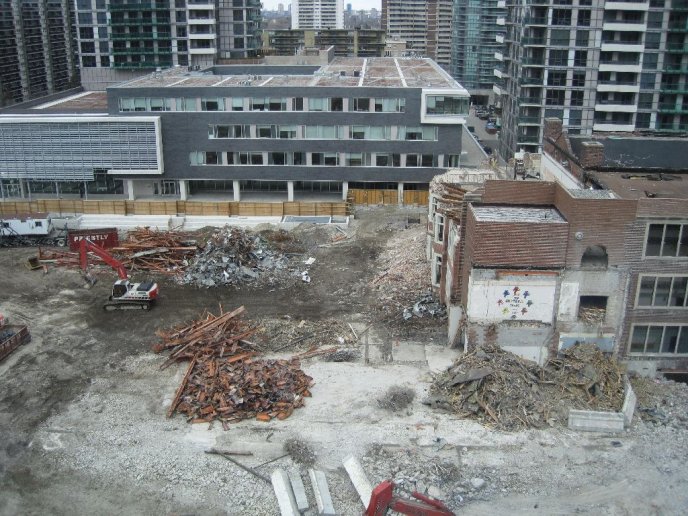
Demolition of original school
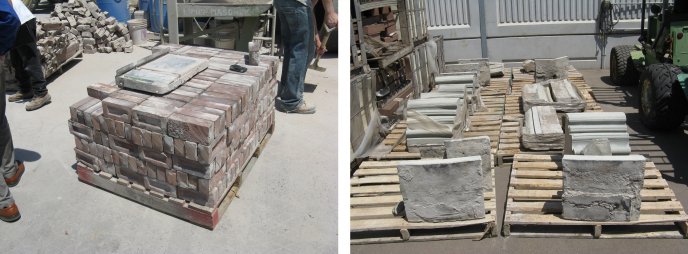
Left: Reclaimed bricks. Right: Salvaged historic stone elements

Left: Aerial view original school site. Right: Aerial view under construction
TOP
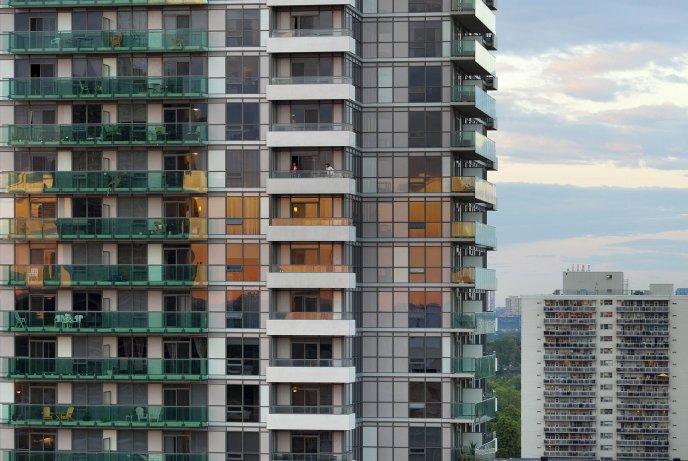
View of Condominium Units
The school and residential developments are designed with future flexibility of use. A broad mix of units are offered in the residential units, offering affordability to a range of users. Knock out panels in the shear walls between the units are provided to offer flexibility of future use for larger families. Future expansion potential is built into the school as a void space, to ensure that the school can continue to meet the needs of the community in the future. The Student Commons is a flexible multipurpose space that functions as a cafeteria, theatre lobby, and student and event space, and may accommodate a variety of events.
The building is designed to reduce or eliminate materials requiring onerous maintenance and regular replacement, thus resulting in reduced life cycle costs. High quality and durable materials were used to ensure that materials are not easily damaged through use. A robust durable building structure and exterior envelope is provided, with the durability LEED credit achieved.
TOP
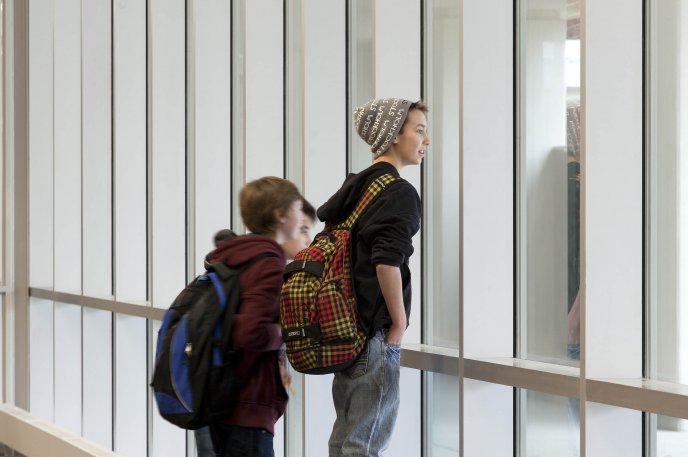
Students at NTCI
An innovative land plan evolved out of a participatory process involving the local community and stakeholders. Sustainable design targets were determined from an integrated design process, together with the owner’s firm commitment to green principles.
The design process for the School and Residences was guided by the Local School and Residential Community Design Teams, and was comprised of community representatives, councillor, students, parents, school staff, alumni, architects and the developer. The community participation in the design of both the school and the residential buildings has set a precedent for similar integrated developments in the City.
A green education program in the school has been implemented, with posters created by the students explaining the school green features. Best Practice Commissioning has trained staff on how to best operate the school and residences. Lectures and publications on this innovative project have been presented by the Owners, Architects and Consultants, to disseminate information about the project and best practices among users, owners, and design professionals.

Section through NTCI theatre and north residential tower
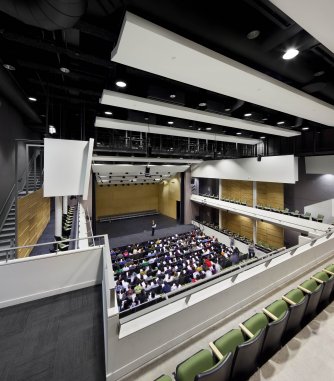
NTCI Theatre: A Community Resource
TOP
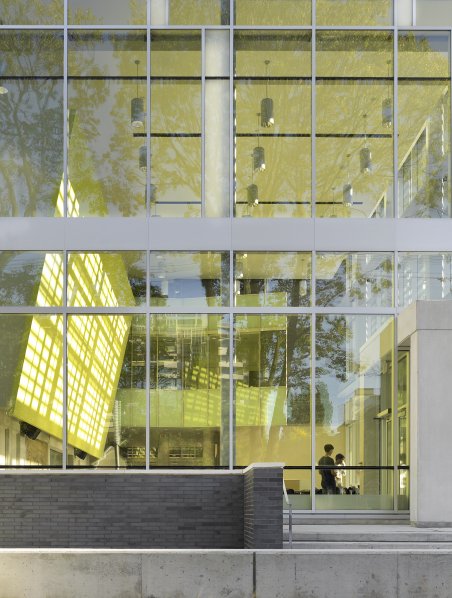
Design Architect: CS&P Architects
Associate Residential Architect: Burka Architects
General Contractor: Deltera
Landscape Architect: NAK Design Group
Civil Engineer: R.V. Anderson Associates Ltd.
Electrical / Mechanical Engineer: MCW Consultants Ltd.
Structural Engineer: Adjeleian Allen Rubeli Ltd.
Interior Design: CS&P Architects
LEED Consultant: Provident
Owner/Developer: TDSB and Tridel
Commissioning Agent: Crossey Engineering Ltd.
Building Envelope Consultant: Jacques Whitford
Quantity Surveyor: Turner & Townsend cm2r Inc.
Acoustics: HCG
Life Safety: Larden Muniak
Geotechnical Engineer: Atira Engineering
Photo Credits: Shai Gill + Tom Arban
TOP